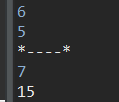动态规划是算法中的一个难点;
思路主要是:
1.将模型抽象,提取出数据之间的抽象关系,并且满足最优解原理;
2.满足最优解,将问题小化为子问题,转化为递推形式;
01背包问题
N=10时:
| i | 1 | 2 | 3 | 4 |
|---|---|---|---|---|
| weight | 1 | 3 | 4 | 5 |
| value | 2 | 5 | 6 | 7 |
对于固定容积(capacity),如何放入,价值最大?
对于这样一个问题,将其划分为若干子问题的前提是该问题符合最优解原理;
参考网络上简单的证明:采用反证法:
s[4]为记录物品装入的组合:exp:(0,1,1,0)中,1表示装入,0表示未装入;
对于容积N的背包:装入物品组合的最优解为s[v1,v2,v3,v4];
{v1,v2,v3,v4}为当前问题的最优解;
对于该背包的子问题(容积小于之前背包i=1的容积时)
{v2,v3,v4}为当前问题最优解;假设当前最优解为{z2,z3,z4}时,那么N时,最优解为v1+{z2,z3,z4};
与{v1,v2,v3,v4}相矛盾,所以该问题复合最优解原理.(即前一状态构成后续阶段决策的最后序列)
满足最优解原理,该算法具有可拆分性;
F(i,j)表示对于j容量的背包,前i件物品最佳组合,所组成的最大价值;
j<w(i)时:F(i,j)=F(i-1,j);
else:
F(i,j)=max(F(i-1,j),F(i-1,j-w(i))+v(i));
F(i-1,j-w(i))+v(i)表示前i-1件在j-w(i)容量下的最优解的价值+该件物品的价值;
所以
j<w(i):F(i,j)=F(i-1,j);
j>=w(i):F(i,j)=max(F(i-1,j),F(i-1,j-w(i))+v(i));
填表j=0时,F(i,0)=0;无法装入任何物品,无价值,F(0,j)=0装入0件物品,无价值(边界条件)
w(1)=1,F(1,1)=F(0,0)+v(1)=2;
F(1,2)=F(0,1)+v(1)=2;
F(1,3)=F(0,2)+v(1)=2;
…
F(1,10)=F(0,9)+v(1)=2;
| i j | 0 | 1 | 2 | 3 | 4 | 5 | 6 | 7 | 8 | 9 | 10 |
|---|---|---|---|---|---|---|---|---|---|---|---|
| 0 | 0 | 0 | 0 | 0 | 0 | 0 | 0 | 0 | 0 | 0 | 0 |
| 1 | 0 | 2 | 2 | 2 | 2 | 2 | 2 | 2 | 2 | 2 | 2 |
| 2 | 0 | ||||||||||
| 3 | 0 | ||||||||||
| 4 | 0 |
i=2时:
w(2)=3
F(2,1)=F(1,1)=2;
F(2,2)=F(1,2)=2;
F(2,3)=max(F(1,3),F(1,0)+v(2))=5;
F(2,4)=max(F(1,4),F(1,1)+v(2))=7;
F(2,5)=max(F(1,5),F(1,2)+v(2))=7;
…
F(2,10)=max(F(1,10),F(1,7)+v(2))=7;
| i j | 0 | 1 | 2 | 3 | 4 | 5 | 6 | 7 | 8 | 9 | 10 |
|---|---|---|---|---|---|---|---|---|---|---|---|
| 0 | 0 | 0 | 0 | 0 | 0 | 0 | 0 | 0 | 0 | 0 | 0 |
| 1 | 0 | 2 | 2 | 2 | 2 | 2 | 2 | 2 | 2 | 2 | 2 |
| 2 | 0 | 2 | 2 | 5 | 7 | 7 | 7 | 7 | 7 | 7 | 7 |
| 3 | 0 | ||||||||||
| 4 | 0 |
i=3时:
w(3)=4
F(3,1)=F(2,1)=2;
F(3,2)=F(2,2)=2;
F(3,3)=F(2,3)=5;
F(3,4)=max(F(2,4),F(2,0)+6)=max(7,6)=7;
F(3,5)=max(F(2,5),F(2,1)+6)=max(7,8)=8;
F(3,6)=max(F(2,6),F(2,2)+6)=8;
F(3,7)=max(F(2,7),F(2,3)+6)=11;
F(3,8)=max(F(2,8),F(2,4)+6)=13;
…
| i j | 0 | 1 | 2 | 3 | 4 | 5 | 6 | 7 | 8 | 9 | 10 |
|---|---|---|---|---|---|---|---|---|---|---|---|
| 0 | 0 | 0 | 0 | 0 | 0 | 0 | 0 | 0 | 0 | 0 | 0 |
| 1 | 0 | 2 | 2 | 2 | 2 | 2 | 2 | 2 | 2 | 2 | 2 |
| 2 | 0 | 2 | 2 | 5 | 7 | 7 | 7 | 7 | 7 | 7 | 7 |
| 3 | 0 | 2 | 2 | 5 | 7 | 8 | 8 | 11 | 13 | 13 | 13 |
| 4 | 0 |
i=4:
w(4)=5
F(4,1)=F(3,1)=2;
F(4,2)=F(3,2)=2;
F(4,3)=F(3,3)=5;
F(4,4)=F(3,4)=7;
F(4,5)=max(F(3,5),F(3,0)+7)=max(8,7)=8;
F(4,6)=max(F(3,6),F(3,1)+7)=9;
F(4,7)=max(F(3,7),F(3,2)+7)=11;
F(4,8)=max(F(3,8),F(3,3)+7)=13;
F(4,9)=max(F(3,9),F(3,4)+7)=14;
F(4,10)=max(F(3,10),F(3,5)+7)=15;
| i j | 0 | 1 | 2 | 3 | 4 | 5 | 6 | 7 | 8 | 9 | 10 |
|---|---|---|---|---|---|---|---|---|---|---|---|
| 0 | 0 | 0 | 0 | 0 | 0 | 0 | 0 | 0 | 0 | 0 | 0 |
| 1 | 0 | 2 | 2 | 2 | 2 | 2 | 2 | 2 | 2 | 2 | 2 |
| 2 | 0 | 2 | 2 | 5 | 7 | 7 | 7 | 7 | 7 | 7 | 7 |
| 3 | 0 | 2 | 2 | 5 | 7 | 8 | 8 | 11 | 13 | 13 | 13 |
| 4 | 0 | 2 | 2 | 5 | 7 | 8 | 9 | 11 | 13 | 14 | 15 |
采用递归方法:
接口:
public interface Bag {
public int MaxFound(int i,int capacity);
}
节点类
public class Node {
private int weight;
private int value;
Node(int weight,int value)
{
this.weight=weight;
this.value=value;
}
public int Getweight()
{
return weight;
}
public int Getvalue()
{
return value;
}
}
import java.util.Scanner;
public class Bagimp implements Bag{
private int size;
private int number;
private Node[] list;
Bagimp()
{
Scanner sc=new Scanner(System.in);
System.out.println("Input the capacity:");
size=sc.nextInt();
System.out.println("Input the number of craft:");
number=sc.nextInt();
list=new Node[number+1];
}
public int getNumber()
{
return number;
}
public int getSize()
{
return size;
}
public void InputValue()
{
Scanner sc=new Scanner(System.in);
int weight,value;
for(int i=1;i<=number;i++)
{
weight=sc.nextInt();
System.out.println("*----*");
value=sc.nextInt();
list[i]=new Node(weight,value);
}
}
//递归算法
public int MaxFound(int i,int capacity)
{
if(i<1||capacity<=0)
{
return 0;
}
else
{
int maxSum;
if(list[i].Getweight()>capacity)
{
maxSum=MaxFound(i-1,capacity);
}
else
{
maxSum=Math.max(MaxFound(i-1,capacity),(MaxFound(i-1,capacity-list[i].Getweight())+list[i].Getvalue()));
}
return maxSum;
}
}
public void display()
{
int Finalfound=MaxFound(number,size);
System.out.println(Finalfound);
}
public static void main(String[] args) {
// TODO Auto-generated method stub
Bagimp s=new Bagimp();
s.InputValue();
s.display();
}
}
输入背包容量10;物品个数4;每件物品所对应的重量,价值如初始表所示:
Input the capacity:
10
Input the number of craft:
4
1
*----*
2
3
*----*
5
4
*----*
6
5
*----*
7
result:

使用动态规划降低复杂度:
使用辅助数组,自下至上记录当前步骤的最大值;
空间复杂度为O(nnumber),时间复杂度为O(nnumber);
//递归空间复杂度过高,呈指数形式递增,采用动规方法降低复杂度
public int MaxFound()
{
int [][] assist=new int[number+1][size+1];//辅助数组记录
//字底向上遍历
for(int i=0;i<=number;i++)
{
for(int j=0;j<=size;j++)
{
if(i==0||j==0)
{
assist[i][j]=0;//边界条件;
}
else if(list[i].Getweight()>j)
{
assist[i][j]=assist[i-1][j];
}
else
{
assist[i][j]=Math.max(assist[i-1][j], (assist[i-1][j-list[i].Getweight()]+list[i].Getvalue()));
}
}
}
return assist[number][size];
}